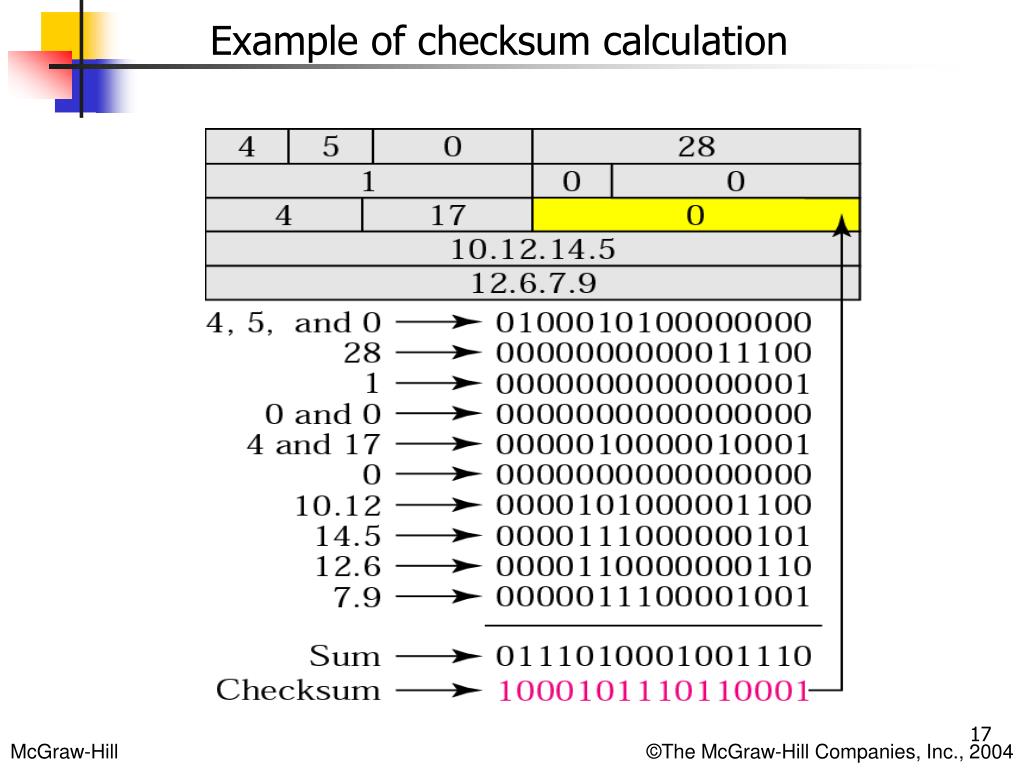
The recipient of the IPv4 packet then creates the checksum of the received header in the same way: Invert¹ 0x2C8B to get the checksum: 0xD374įinally, insert the checksum into the header: 45 00 00 34 5F 7C 40 00 40 06 C0 A8 B2 14 C6 FC CE 19.The leading digit 4 is the carry count, we add this to the rest of the number to get 0x2C8B: bc Let's see how the sender of the packet calculates the header checksum: We can mentally split up this header as a sequence of ten 16-bit values: 0x4500, 0x0034, 0x5F7C, etc. The checksum's value is initially set to zero.

The two bytes in square brackets is where the checksum will go. The sender hasn't calculated the checksum yet. These are the twenty bytes of our example packet header: 45 00 00 34 5F 7C 40 00 40 06 C0 A8 B2 14 C6 FC CE 19 Consequently, it should be easy to reproduce the results on Linux by copy-pasting the commands. In the following example, I use bc, printf and here strings to calculate the header checksum and verify it. The initial value for cval is 0.Here's a complete example with a real header of an IPv4 packet. Our one byte checksum example could have been calculated with the following function (in C language) that we call repeatedly for each byte in the input string. In fact checksum calculations as described above can be defined in this way. Use a function F(bval,cval) that inputs one data byte and a check value and outputs a recalculated check value. The idea behind a check value calculation is simple. So calculating a checksum may be a simple method for detecting errors, but doesn’t give much more protection than the parity bit, independent of the length of the checksum. Even if we had used a four byte long checksum we would not have detected this transmission error. The checksum for this new string is still 210, but the result is obviously wrong, only after two bits changed. The receiver will than see the array representing the string “ M`mmert“. Let us assume that in our example array the lowest significant bit of the character ‘ L‘ is set, and the lowest significant bit of character ‘ a‘ is lost during communication. They often fail in bursts, or due to electrical spikes. In practice, bits do not change purely random during communications.

Seems rather good, but this is only theory. We might conclude that with a four byte checksum the chance that we accidentally do not detect an error is less than 1 to 4 billion. Using a two byte checksum will result in 65,536 possible different checksum values and when a four byte value is used there are more than four billion possible values. In this example we have used a one byte long checksum which gives us 256 different values. You can use the calculator above to check this result. The one byte checksum of this array can be calculated by adding all values, than dividing it by 256 and keeping the remainder. The example string is “ Lammert” which converts to the ASCII values. Lets take an example string and calculate a one byte checksum. It is certainly easier to calculate a checksum, but checksums do not find all errors. One might think, that using a checksum can replace proper CRC calculations. The answer is simple, they are powerful, detect many types of errors and are extremely fast to calculate especially when dedicated hardware chips are used. So let’s see why they are so widely used. Modern computer world cannot do without these CRC calculation. Also each data block on your hard-disk has a CRC value attached to it. All packets sent over a network connection are checked with a CRC. Nowadays CRC calculations are used in all types of communications. The CRC calculation or cyclic redundancy check was the result of this. To overcome this problem people have searched for mathematical sound mechanisms to detect multiple false bits. This simple detection mechanism works if an odd number of bits in a byte changes, but an even number of false bits in one byte will not be detected by the parity check.
#I2cs checksum calculator serial#
For serial data they came up with the solution to attach a parity bit to each sent byte. Since the beginning of computer science, people have been thinking of ways to deal with this type of problem. Whenever digital data is stored or interfaced, data corruption might occur.


 0 kommentar(er)
0 kommentar(er)
